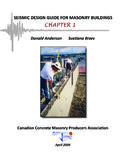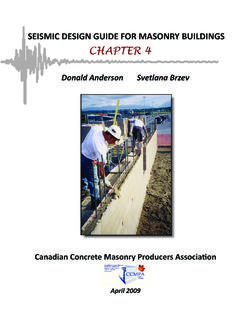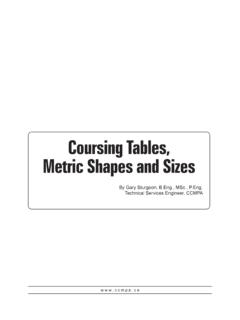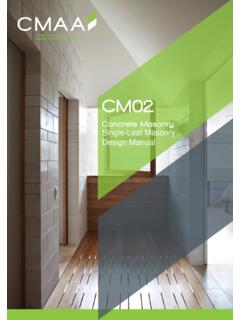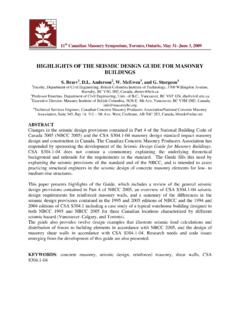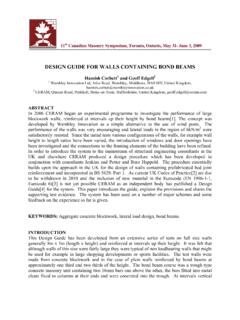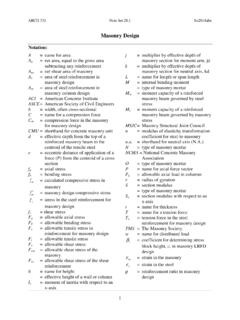Transcription of SEISMIC DESIGN GUIDE FOR MASONRY BUILDINGS
1 SEISMIC DESIGN GUIDE FOR MASONRY BUILDINGS Canadian Concrete MASONRY Producers AssociationDonald Anderson Svetlana BrzevApril 2009 DISCLAIMER While the authors have tried to be as accurate as possible, they cannot be held responsible for the designs of others that might be based on the material presented in this document. The material included in this document is intended for the use of DESIGN professionals who are competent to evaluate the significance and limitations of its contents and recommendations and able to accept responsibility for its application.
2 The authors, and the Canadian Concrete MASONRY Producers Association, disclaim any and all responsibility for the applications of the stated principles and for the accuracy of any of the material included in the document. AUTHORS Don Anderson, , Department of Civil Engineering, University of British Columbia Vancouver, BC Svetlana Brzev, , Department of Civil Engineering British Columbia Institute of Technology Burnaby, BC TECHNICAL EDITORS Gary Sturgeon, , Director of Technical Services, CCMPA Bill McEwen, , LEED AP, Executive Director, MASONRY Institute of BC Dr.
3 Mark Hagel, EIT, Technical Services Engineer, CCMPA GRAPHIC DESIGN Natalia Leposavic, COVER PAGE Photo credit: Bill McEwen, Graphic DESIGN : Marjorie Greene, AICP COPYRIGHT Canadian Concrete MASONRY Producers Association, 2009 Canadian Concrete MASONRY Producers Association Box 54503, 1771 Avenue Road Toronto, ON M5M 4N5 Tel: (416) 495-7497 Fax: (416) 495-8939 Email: Web site: The Canadian Concrete MASONRY Producers Association (CCMPA) is a non-profit association whose mission is to support and advance the common interests of its members in the manufacture, marketing, research, and application of concrete MASONRY products and structures.
4 It represents the interests of Region 6 of the National Concrete MASONRY Association (NCMA). iContents Summary Chapter 1 NBCC 2005 SEISMIC Provisions Objective: to provide background on SEISMIC response of structures and SEISMIC analysis methods and explain key NBCC 2005 SEISMIC provisions of relevance for MASONRY DESIGN DETAILED NBCC SEISMIC PROVISIONS Chapter 2 SEISMIC DESIGN of MASONRY Walls to CSA Objective: to provide background and commentary for CSA SEISMIC DESIGN provisions related to reinforced concrete MASONRY walls, and discuss the revisions in CSA SEISMIC DESIGN requirements with regard to the 1994 edition DETAILED MASONRY DESIGN PROVISIONS Chapter 3 Summary of Changes in NBCC 2005 and CSA SEISMIC DESIGN Requirements for MASONRY BUILDINGS Objective.
5 To provide a summary of NBCC 2005 and CSA changes with regard to previous editions (NBCC 1995 and CSA ) and to present the results of a DESIGN case study of a hypothetical low-rise MASONRY building to illustrate differences in SEISMIC forces and MASONRY DESIGN requirements due to different site locations and different editions of NBCC and CSA SUMMARY OF NBCC AND CHANGES Chapter 4 DESIGN Examples Objective: to provide illustrative DESIGN examples of SEISMIC load calculation and distribution of forces to members according to NBCC 2005, and the SEISMIC DESIGN of loadbearing and nonloadbearing MASONRY elements according to CSA DESIGN EXAMPLES Appendix A Comparison of NBCC 1995 and NBCC 2005 SEISMIC Provisions Appendix B Research Studies and Code Background Relevant to MASONRY DESIGN Appendix C Relevant DESIGN Background Appendix D DESIGN Aids Appendix E Notation ii Table of Contents 1 SEISMIC DESIGN PROVISIONS OF THE NATIONAL building CODE OF CANADA 2005 1-2 Introduction
6 1-2 Background 1-2 DESIGN and Performance Objectives 1-3 Response of Structures to Earthquakes 1-4 Elastic Response 1-4 Inelastic Response 1-8 Ductility 1-9 A Primer on Modal Dynamic Analysis Procedure 1-10 SEISMIC Analysis According to NBCC 2005 1-19 SEISMIC Hazard 1-19 Effect of Site Soil Conditions 1-20 Methods of Analysis 1-23 Base Shear Calculations- Equivalent Static Analysis Procedure 1-24 Force Reduction Factors dR and oR 1-27 Higher Mode Effects (vM factor)
7 1-28 Vertical Distribution of SEISMIC Forces 1-30 Overturning Moments (J factor) 1-31 Torsion 1-32 Configuration Issues.
8 Irregularities and Restrictions 1-40 Deflections and Drift Limits 1-44 Dynamic Analysis Method 1-46 Soil-Structure Interaction 1-47 2 SEISMIC DESIGN OF MASONRY WALLS TO CSA 2-2 Introduction 2-2 MASONRY Walls Basic Concepts 2-2 Reinforced MASONRY Shear Walls Under In-Plane SEISMIC Loading 2-8 Behaviour and Failure Mechanisms 2-8 Shear/Diagonal Tension Resistance 2-10 Sliding Shear Resistance 2-18 In-Plane Flexural Resistance Due to Combined Axial Load and Bending 2-20 iii Reinforced MASONRY Walls Under Out-of-Plane SEISMIC Loading 2-20 Background
9 2-20 Out-of-Plane Shear Resistance 2-21 Out-of-Plane Sliding Shear Resistance 2-22 Out-of-Plane Section Resistance Due to Combined Axial Load and Bending 2-22 SEISMIC DESIGN Considerations for Reinforced MASONRY Shear Walls 2-23 Background 2-23 Capacity DESIGN Approach 2-23 Ductile SEISMIC Response 2-28 CSA SEISMIC DESIGN Requirements 2-28 Summary of SEISMIC DESIGN Requirements for Reinforced MASONRY Walls 2-52 Special Topics
10 2-54 Unreinforced MASONRY Shear Walls 2-54 MASONRY Infill Walls 2-59 Stack Pattern Walls 2-67 Nonloadbearing Walls 2-71 MASONRY Veneers and their Connections 2-72 Boundary Elements and Flanged Shear Walls 2-75 Wall-to-Diaphragm Anchorage 2-78 Constructability Issues 2-79 3 SUMMARY OF CHANGES IN NBCC 2005 AND CSA SEISMIC DESIGN REQUIREMENTS FOR MASONRY BUILDINGS 3-2 Introduction

